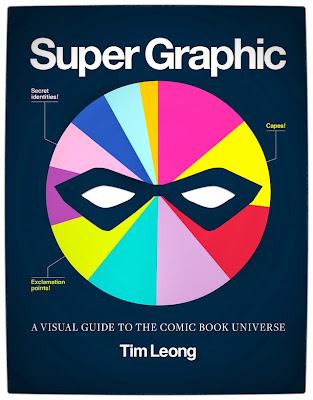Then there are the parasitoid wasps of knowledge that find my brain. They grab hold immediately and lay their eggs inside, and- hold on, this is disgusting, let's find a new analogy.
Ophiocordyceps unilateralis is a parasitic fungus that infects ants. It co-opts the mind of the insect it infects, forcing it to behave in a way outside of its nature in order to spread its own growth. In nature, the fungus makes an ant climb a plant or tree, clamp its mandibles shut on a leaf to lock it in place, and then kills the host so it can consume the body and spread its spores.
In the instance of the book Super Graphic, I'm not really acting outside of my normal behavior, but I have become completely fixated on this book. Now, after reading through it twice, I feel compelled to share it with all of you before I go read it a third time.
Originally I wrote out a paragraph here that devolved into a rather poor parody of the Spanish Inquisition sketch from Monty Python ("amongst our weaponry are such diverse elements as..."), but I decided I'd delete it and just go with the end result:
Out of my many deeply-rooted interests, two I'm a huge fan of are math and superheroes. When you combine these two things, that tiny little primitive part of my brain kicks in and makes me want to grab hold, the same way a dog will abandon whatever it's doing to chase that ball you just tossed.
Tim Leong, in his genius, wrote the book I wish I could take any and/or all credit for making, as he charted out the most minute details of superheroes and comic books. While not every single fact is listed and some more obscure characters are omitted from specific articles, it makes sense because if every character from every comic book company was included you'd have a series of books that rivalled the Encyclopedia Brittanica series.
To my younger readers, the Encyclopedia Brittanica series are those dusty books in the corner of your school library that nobody ever used since they invented Wikipedia.
The book expresses, with no pretense of hiding it behind any kind of scholarly or academic function, a pure love of comic books and the things that make up the bizarre hobby, whether it's the differences between western comics and manga, cosplaying at conventions, or behind the scenes details at companies. Every possible topic is looked at, broken down, and presented in informational (and often humorous) ways.
Now, suppose you wanted a Venn diagram detailing where various heroes and villains fit into common superhero tropes? There's a brilliantly colored chart for that.
Suppose you want to learn more about the deep connections between comic book superheroes and rap music? There's a series of charts for that.
Suppose you want a diagram describing the paths you should take when meeting anybody when you're the Punisher?
You see where I'm going here.
The book contains pages upon pages of things like "color breakdowns of common superhero/villain costumes," statistics comparing the Avengers Quinjet to the X-Men's Blackbird, and a breakdown of every race held by Superman and the Flash, amongst so many others. As the author put it in an interview with Comics Alliance, he has several hundred hours of research involved in the book, and it shows in the details like a comparison of how many people in The Walking Dead died from zombies compared to deaths caused by other humans, and then a chart breaking down how many people died per issue of said comic.
I cannot recommend this book enough for people, to the point that if someone was interested in reading it, I would consider mailing them my own copy for them to read first so they can decide to buy it. You know, as long as I can get it back. I'd probably feel compelled to read it again before too long.
Now if you'll excuse me, I feel compelled to go climb a tree.




No comments:
Post a Comment